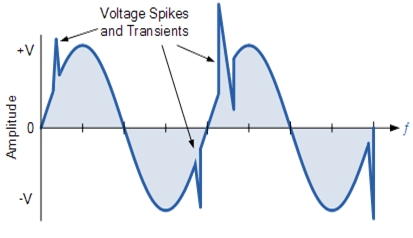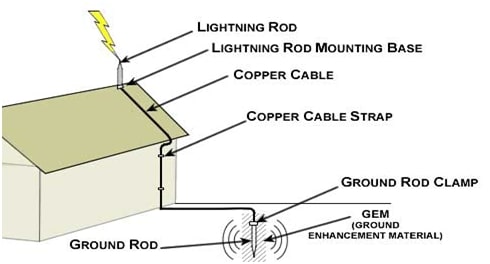As a warrior can’t fight without his shield an electrical system can’t withstand without a well-designed protection system. So protection is a must in any power system, and it’s applied at all voltage levels and for personnel or equipment protection and many other purposes. We can categorize protection according to the event leading a protection device to operate, such as overcurrent protection, earth fault protection, overvoltage protection and many other events.

Fig.1 Voltage spike effect on system voltage
Throughout this article, we are going to discuss voltage spikes (overvoltage) protection in low voltage installations, which may occur as a spike or with nominal frequency. And we will provide you with an overview about reasons why it occurs and how you can protect you installations against it.
Firstly let’s define what is a voltage spike? It’s a fast duration voltage transient or impulse which is superposed on system’s voltage and lasts for micro or mille seconds. It’s also known as surges which cause disturbance to the system. These surges propagate along a transmission line or a cable applying a severe stress on insulation.
Classification of voltage spikes according to its source.
Internal sources
- Operating voltage surges: it’s common for high frequency range from ten to hundred kilohertz which decays rapidly till nominal frequency (around 500ms), mainly it occurs due to switching of Circuit breakers, Fuses, motors and capacitive circuit.
- Transient overvoltage: it has system’s nominal frequency and it develops as a result for common faults such as insulation failure between two phases, thus the equipment will suffer a line voltage (400v instead of 230v).
External sources
Atmospheric discharge (lightning): the most severe and common voltage spike. Which lasts for nearly 10-100 μs with voltage peak reaches 1 million volts; it strikes transmission lines and facilities too.
Why is this harmful?
Let’s imagine that you are at home and unexpectedly you hear a boom with a smoky smell, then you realize that your TV, fridge, and many of your home appliances are burnt. This simply can happen due to a voltage spike, but usually the low voltage distributer in your area have protection against voltage surges so you may never had this experience.
But what if you are working in a factory which have a production line and in a stormy rainy day there was lightning striking the factory, and in case you don’t have protection against voltage spikes, you will have a really bad day. Lightning can damage the whole production line in a second causing all equipment to be electrically burnt and this is a disaster for the owner.
Also voltage spikes can cause tripping of circuit breaker and this directly affects system stability as it leads to outage of feeder and discontinuity of service.
As these abnormal conditions affect system stability and can lead to insulation failure for cables and Disastrous consequences for personnel and systems too, then we need to implement protection devices against it. And we will discuss how a low voltage system can be protected against such disturbances and devices which used too.
Protection devices and techniques
Primary protection
It’s protection of installations and buildings against atmospheric discharge. We always notice the high rise buildings have a metal rod at its highest point. As these buildings are high, they are the closest to lightning to strike. There are many techniques of primary protection which all aims to capturing the lightning and pass into the ground.
1. Lightning rods, the most simple, conventional way and widely used. It’s a pointed rod placed at the roof of a building and connected to copper conductors which in turns connected to the ground.
Due to the severe current caused by lightning, it develops a strong electromagnetic field which may cause damage to equipment thus it’s common to use four or more conductors to split the current and weaken magnetic field.

Fig.2 Lightning rod connection schema
2. Overhead earth wires: a suspended wire above the facility. They are commonly used for OHTL protection and some specific facilities such as military applications and rocket stations.

Fig.3 Lightning protection for a house using overhead earth
3. Faraday cage: a grid of horizontal and vertical conductors mounted on the structure sides and roof. This technique is used for very sensitive buildings which houses computers, servers or electronic circuits’ production lines. So when a lightning strike the building, its current is distributed among these conductors reducing magnetic field greatly and preventing destruction to these sensitive devices.

Fig.4 A meshed grid of conductors forming Faraday cage
Secondary protection
This type of protection is for internal equipment against voltage surges at nominal frequency. There are two types of this protection, the series and parallel protection.
The first type is series protection; series protection implements devices in series with supply to act as a filter, damper or high impedance in front of voltage surges.
- Wave absorber: basically it’s a coil which limits voltage surges by absorbing the currents. They are widely used in very sensitive electronic equipment.
- Filters: a circuit consists of inductors and capacitors; mainly they are suitable for protection against a disturbance with a pre-defined frequency. They are similar to band-pass filters.
The second type is parallel protection; it does the same function as series one but it’s connected to the circuit in parallel with the supply and to the ground. The device rated voltage must be suitable for the network voltage where it’s installed.
So how these devices work, simply in normal operation there is no spikes, then a leakage current will pass through the device. But when a voltage spike occur it acts as a short circuit connected to ground thus the surge current pass through ground and the equipment get no harm.
Parallel protection is the most common technique in low voltage internal installation protection as it’s simple in installation.
Finally, you now know how harmful these phenomena can affect your system and how to get your system protected, so according to the system importance you will choose a technique of protection. But you need to follow the local or global standards whenever a protection device is implemented.